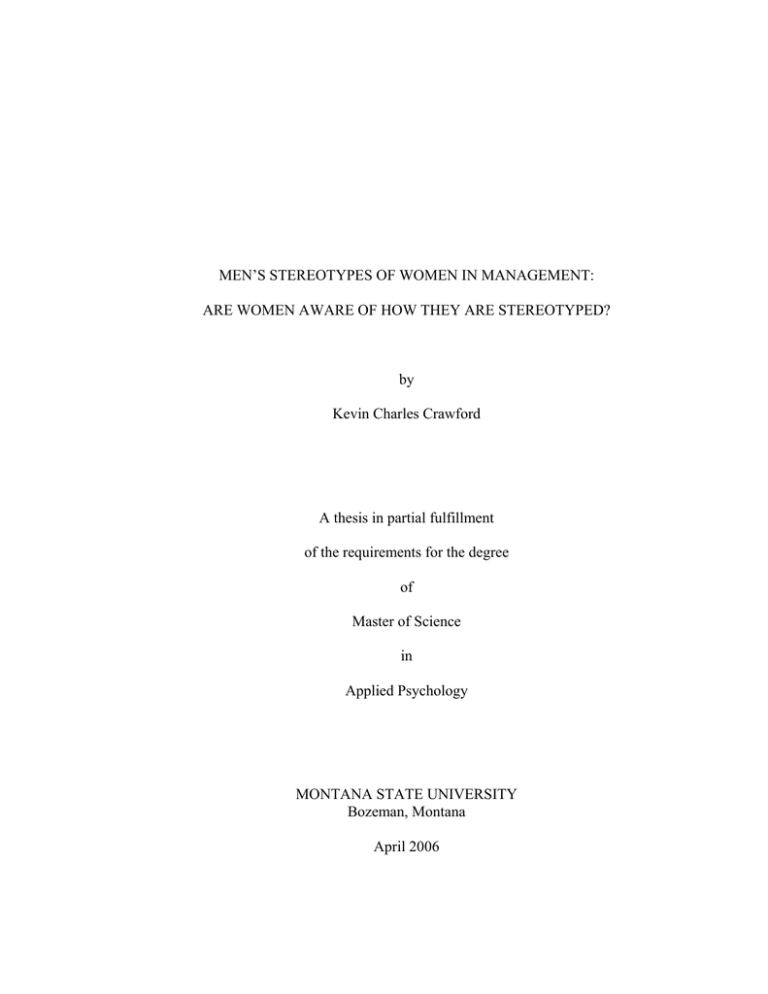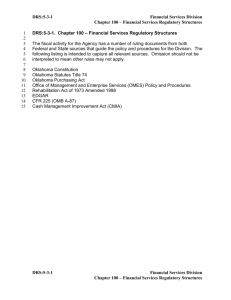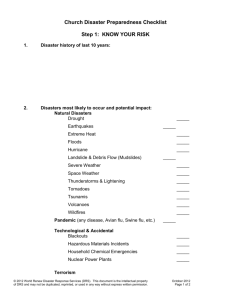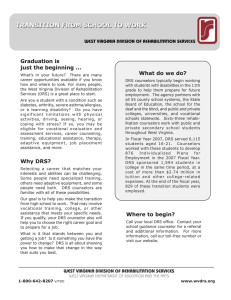
MEN’S STEREOTYPES OF WOMEN IN MANAGEMENT:
ARE WOMEN AWARE OF HOW THEY ARE STEREOTYPED?
by
Kevin Charles Crawford
A thesis in partial fulfillment
of the requirements for the degree
of
Master of Science
in
Applied Psychology
MONTANA STATE UNIVERSITY
Bozeman, Montana
April 2006
©COPYRIGHT
by
Kevin Charles Crawford
2006
All Rights Reserved
ii
APPROVAL
of a thesis submitted by
Kevin Charles Crawford
This thesis has been read by each member of the thesis committee and has been
found to be satisfactory regarding content, English usage, format, citations, bibliographic
style, and consistency, and is ready for submission to the Division of Graduate Education.
Dr. Richard A. Block
Approved for the Department of Psychology
Dr. Richard A. Block
Approved for the Division of Graduate Education
Dr. Joseph Fedock
iii
STATEMENT OF PERMISSION TO USE
In presenting this thesis in partial fulfillment of the requirements for a master’s
degree at Montana State University, I agree that the library shall make it available to
borrowers under rules of the Library.
If I have indicated my intention to copyright this by including a copyright notice
page, copying is allowable only for scholarly purposes, consistent with “fair use” as
prescribed in the U.S. Copyright Law. Requests for extended quotation from or
reproduction of this thesis in whole or in parts may be granted only by the copyright
holder.
Kevin C. Crawford
iv
TABLE OF CONTENTS
Page
LIST OF TABLES ..............................................................................................................v
LIST OF FIGURES ........................................................................................................... vi
ABSTRACT...................................................................................................................... vii
1. INTRODUCTION ......................................................................................................... 1
2. METHOD .......................................................................................................................6
Participants.....................................................................................................................6
Measurement Instrument ..............................................................................................6
Procedure ...................................................................................................................... 7
3. RESULTS .......................................................................................................................9
4. DISCUSSION ...............................................................................................................17
5. CONCLUSION.............................................................................................................19
REFERENCES CITED......................................................................................................21
v
LIST OF TABLES
Table
Page
1. Comparisons of DRs for Previous Male and Present Female Raters on Each
Category …………………………………………………………………………... 10
2. Comparisons of DRs for Previous Male and Present Male Raters on Each
Category …………………………………………………………………………... 14
3. Comparisons of DRs for Present Male and Present Female Raters on Each
Category ……………………………………………………………………….….. 16
vi
LIST OF FIGURES
Figure
Page
1. Scatterplot of present female DRs versus previous male DRs ……….…….…..… 12
2. Scatterplot of present male DRs versus previous male DRs…………….………… 15
3. Scatterplot of present male DRs versus present female DRs………………...……. 17
vii
ABSTRACT
It is commonly thought that men and women differ in the extent or frequency to
which each exhibits various traits—especially traits that are frequently perceived to be
more agentic and stereotypical of males (e.g., aggressive and forceful) or more communal
and stereotypical of females (e.g., interpersonally sensitive and sympathetic). Further,
stereotypes frequently influence behaviors, with many real-world consequences, not the
least of which are those often manifested in the disparate treatment of men and women in
the workplace. In a recent study (Martell & DeSmet, 2001), male MBA students rated
male and female managers on 14 items considered important to achieving success as a
manager. Because having a realistic job preview is an important component of success at
one’s work, the present study explored the accuracy of Business and Management
students’ perceptions of male stereotypes of female versus male managers’ leadership
abilities. Results revealed a remarkable ability of respondents to closely predict the
previous men’s responses. In comparing current respondents’ ratings to Martell and
DeSmet’s males’ ratings, few significant differences were observed between men’s
estimates of female managers’ abilities and the current respondents’ expectations of those
men’s beliefs.
1
INTRODUCTION
Stereotypes are organized sets of beliefs about the traits, attributes, and behavioral
tendencies thought to distinguish one group from another. One aspect on which many
people exhibit strong stereotypes is that of gender-based trait differences. Many people
expect men to be more agentic than women. That is, men are viewed as being more
aggressive, ambitious, dominant, forceful, independent, self-sufficient, and selfconfident. In contrast, many people expect women to be more communal than men. That
is, women are viewed as being more affectionate, compassionate, helpful, kind,
sympathetic, interpersonally sensitive, and gentle (Bakan, 1966; Eagly, 1987; Schein,
Mueller, & Jacobsen, 1989).
One important reason to study gender stereotypes is that beliefs regarding how
men and women differ are often translated into action. Indeed, considerable evidence
reveals that men and women are perceived and treated differently in a variety of contexts,
such as in the workplace (e.g., Heilman, Block, & Martell, 1995; Jackson, Sullivan, &
Hodge, 1993; Schein, 1973).
As women began to enter previously male-dominated occupations, researchers
developed an interest in how female managers would be perceived and treated in the
workplace compared to male managers. The results of several decades of research reveal
that women are perceived in a stereotypic fashion, often characterized as lacking what it
takes to succeed in management (e.g., Eagly, Makhijani, & Klonsky, 1992; Heilman,
Block, Martell, & Simon, 1989; Martell, Parker, Emrich, & Crawford, 1997). Schein et
2
al. (1989), for example, stated that male managers “still adhere to the male managerial
stereotype and perceive that successful middle managers possess characteristics . . . more
commonly ascribed to men in general than to women in general” (p. 103).
Research provides abundant evidence that, compared to their male counterparts,
female managers are judged less favorably on a range of personnel assessments,
including hiring, placement, performance assessment, and promotion (Bartol, 1999;
Bowen, Swim, & Jacobs, 2000; Cohen, Broschak, & Haveman, 1998; Davison & Burke,
2000; Dipboye, Fromkin, & Wiback, 1975; Eagly & Karau, 2000; Eagly et al., 1992;
Heneman, 1997; Olian, Schwab, & Haberfeld, 1988; Perry, Davis-Blake, & Kulik, 1994).
If unchecked, differential treatment based on gender stereotypes will continue to pose
significant obstacles to women in management.
Surprisingly, despite an enormous body of research on how female managers are
perceived and treated, little attention has been devoted to an issue of critical importance:
How aware are women of the stereotypically negative light in which they are viewed in
organizational settings? That is, are women aware of the extent to which they are viewed
as less well suited for management positions by their male counterparts? Consider, for
example, a woman who assumes a management position expecting an absence of
negative, gender-based stereotyping and, consequently, expects to be perceived and
treated no differently than a man. Research on the effects of job expectations that are
inaccurate or unrealistic suggests that an overly optimistic outlook may be setting hirees
up for disappointment later, with the possibility of lowered job satisfaction,
3
organizational commitment, and job performance (Wanous, Poland, Premack, & Davis,
1992). One example of unrealistic expectations would be if women underestimated men’s
beliefs in male-manager superiority in the workplace.
The present study examined women’s beliefs regarding male managers’
stereotype of women in management. In so doing, I was particularly interested in
addressing the area of leadership ability, because leadership is central to success in
management and women are often seen as lacking in what it takes to excel as leaders.
Accordingly, the main question that this study will address is: To what extent are women
accurate in their perception of male managers’ beliefs regarding the leadership abilities of
female managers?
To answer this question, it is critical to know how female managers are perceived
with respect to their leadership abilities. Leadership abilities include an extensive set of
behaviors most accurately measured using multi-item surveys. For this reason, I used a
14-category instrument in the present study, based on the Managerial Practices Survey
(MPS; Yukl, 1994; Yukl, Wall, & Lepsinger, 1989), as modified by Martell and DeSmet
(2001) in their study of male managers’ stereotypes of men and women in management.
In that study, Martell and DeSmet investigated men’s stereotypes of female
managers, asking “what percentage of male managers and what percentage of female
managers” exhibit each type of leadership quality, thus allowing for a direct comparison
of percentages between the two groups. This approach, first proposed by McCauley and
4
Stitt (1978), allows stereotypes of males and females to be compared using a so-called
diagnostic ratio (DR), in which:
p(behavior exhibited by male managers)
DR =
_____________________________________________________
(1)
p(behavior exhibited by female managers)
where p is the probability of a behavior being exhibited. Additionally, DRs are centered
at 1. Therefore, a DR differing significantly from 1 (in either a positive or negative
direction) is evidence of a significant difference in male and female perception of the
males’ stereotype content.
Martell and DeSmet (2001) also predicted that different subtypes of their survey’s
hypothetical female manager might influence respondents’ perceptions of her (Deaux,
Winton, Crowley, & Lewis, 1985). Thus, providing evidence that a woman is a
successful manager might moderate the typically negative stereotype and lead
participants to evaluate her more favorably. They therefore administered two versions of
the questionnaire, alternately using middle-manager and successful middle-manager
descriptives.
By using the survey instrument and analysis techniques used by Martell and
DeSmet, the present study explored the extent of women’s awareness of male managers’
stereotype of female managers, and in such a way as to allow direct comparisons of the
men’s stereotype with women’s awareness of it. The hypothesis was that women do not
have an accurate view of male managers’ stereotype of them and, specifically, that they
would predict a more positive appraisal than was actually reported by male managers.
5
Specifically, then, I hypothesized that:
1. Women are largely unaware of the actual content of male managers’ stereotype of
female managers’ abilities, and will therefore significantly underestimate actual malebiased responses, predicting a more positive overall male response than was observed by
Martell and DeSmet (2001).
2. Specifying that the woman is a “successful” manager will moderate the extent to which
any pro-male bias is reported on the items surveyed.
6
METHOD
Participants
Questionnaires were distributed to 107 women and 103 men. The women were 10
students in an entry-level business course at Montana State University (hereafter the
Naïve group), 77 students in upper-level Business and Management courses at Montana
State University (hereafter, the Advanced group), and 20 students either currently in, or
graduates of, the MBA program at the University of Montana–Billings (hereafter, MBAs).
Of the women who participated, 103 were Caucasian, 1 was Asian, 1 was Hispanic, 1
reported Other, and 1 did not report ethnicity. Ages ranged from 18 to 53 (M = 24.2).
The men were 23 students in the Naïve group, 55 students in the Advanced group,
and 25 students in the MBAs group. Of the men who participated, 96 were Caucasian, 2
were Asian, 2 were Native American, 2 were Hispanic, 1 reported Other, and 1 did not
report ethnicity. Ages ranged from 18 to 51 (M = 24.2).
Measurement Instrument
The measurement instrument used in this study was identical to the instrument
used in Martell and DeSmet’s (2001) study, with the addition of further instructions
stating that the issue involved was to try to predict what the male managers in a previous
study reported, and not the participant’s own opinions. The instrument included 14
categories of leadership behavior, 11 from the MPS (Yukl, 1994; Yukl et al., 1989), 1
7
from the Managerial Leadership Questionnaire (MLQ; Bass, 1985), and 2 other behaviors
considered in the literature as critical to success as a leader. In all, the 14 categories used
were: Consulting, Delegating, Inspiring, Intellectual Stimulation, Mentoring, Modeling,
Monitoring, Networking, Planning, Problem Solving, Rewarding, Supporting, Team
Building, and Upward Influence.
A total of 60 participants received one form of the instrument (Form A, hereafter
called the manager condition). On it, participants were instructed to “estimate what male
managers believe to be the percentage of male middle managers, and of female middle
managers, who are likely to demonstrate each leadership behavior effectively.” Each
category of leadership behavior (for example, Consulting) was then described by three
concrete examples of actions which constitute that behavior. A total of 47 participants
received another form of the instrument (Form B, hereafter called the successful manager
condition), instructions differed only in the addition of the word successful—that is, “the
percentage of successful male middle managers” and “the percentage of successful
female middle managers.”
Procedure
A cover letter describing the purpose of the study as a university-based
investigation of current leadership practices prefaced the survey. Participants were asked
to complete the survey after being instructed that participation was voluntary. The survey
was randomly distributed between Form A and Form B and, to insure the anonymity of
8
respondents (and to reduce social desirability concerns), it was made clear that
participants’ names would not be recorded.
The survey asked participants to make percentage estimates of the expected
ratings made by male managers of male and female managers’ leadership abilities.
Ratings on each of the 14 items were made on the percentage of male managers and the
percentage of female managers who were expected to exhibit each leadership behavior.
Results of both female and male respondents for this study’s questionnaire were
compared to the male respondents of the Martell and DeSmet (2001) study, using a 2 ×
14 × 2 MANOVA (Respondent Sex × Behavior Category × Form).
9
RESULTS
Each percentage estimate was converted to a probability by dividing it by 100.
For each participant, a DR was then computed for each of the 14 paired responses (see
Equation 1). Suppose that male baseline DR data from Martell and DeSmet (2001)
showed a DR = +1.5 for an item titled, “Percentage of successful male and female
managers exhibiting leadership behavior x” (indicating that male respondents perceive
that more male than female managers exhibit this behavior). If DR = +1.0 for present
female respondents (indicating the belief that males and females exhibit an equal amount
of behavior x), the discrepancy between the two DRs is then +0.5 (indicating the
difference between the previous male and present female perceptions of the male
managers’ stereotype of female managers).
An equivalency transformation was used to insure parity between scores ranging
from 0 to 1, and scores ranging from 1 to ∞ (McCauley & Stitt, 1978): Scores greater
than or equal to 1 were transformed by subtracting 1 from the original DR, whereas
scores less than 1 were transformed by subtracting the inverse of the DR from 1. Finally,
as in Martell and DeSmet (2001), extreme outlying DRs were truncated at +4.5 and −4.5,
and all further computations were made using these final DRs.
For each of the 14 behavior categories and 210 respondents, the previous mean
male DR was subtracted from the present DR, yielding a difference score. Difference
scores were analyzed using a 14 (Behavior Category) × 2 (Participant Gender) × 2 (Form)
MANOVA. The main effect of behavior category was significant, F(13, 2314) = 5.92, p
10
< .001. The interaction of behavior category and form was not significant, F(13, 2314) =
1.58, p = .08. No other main effect or interaction effect was significant, all Fs < 1.80, ps
> .18.
Previous male data versus present female data. For each category of leader
behavior, I calculated the mean DR of the previous (Martell & DeSmet, 2001) male
respondents, the mean DR of the present female respondents, the difference between the
two DRs, and the size of the effect (d). Table 1 shows the resulting means, along with
relevant standard deviations. Across the 14 behavior categories, the overall mean of the
previous male DRs (0.09) and the overall mean of the present female DRs (0.10) did not
differ significantly, t(13) = 0.19, p = .85. In other words, there was no overall difference
in gender bias between the two kinds of respondents: The present female respondents
were very close to the previous male respondents in their overall ratings of the 14 leader
behavior categories.
The difference between the 14 pairs of DRs was tested by conducting 14 planned
comparisons (independent-groups t tests), using a Bonferroni adjustment to control for
the overall Type I error rate. (Hence, p < .0036 per comparison is a significant
difference.) A significant difference between previous male DRs and present female DRs
was found for only one category of leader behavior (Modeling, p = .0009), although the
effect size d is what Cohen (1988) called a medium effect. All the other effect sizes are
referred to as small.
11
Table 1
Comparisons of DRs for Previous Male and Present Female Raters on Each Category
________________________________________________________________________
Femaleb
Differencec
Effect
Leader behavior
Malea
category
M
SD
M
SD
M
size (d)
________________________________________________________________________
Consulting
−0.23 0.96
−0.33 1.02
−0.10
0.10
Delegating
0.32 0.94
0.34 0.74
0.02
0.02
Inspiring
0.20 0.91
−0.02 1.02
−0.22
0.23
Intellectual Stimulation
0.22 0.83
0.26 1.04
0.04
0.04
Mentoring
0.04 0.87
−0.04 0.97
−0.08
0.09
Modeling
0.04 0.67
0.43 0.94
0.39*
0.47
Monitoring
0.02 0.71
0.21 0.94
0.19
0.23
Networking
0.09 0.91
0.11 0.85
0.02
0.02
Planning
0.05 0.93
0.10 0.81
0.05
0.06
Problem Solving
0.34 1.00
0.45 0.81
0.11
0.12
Rewarding
−0.05 0.95
−0.18 0.66
−0.13
0.16
Supporting
−0.14 0.84
−0.38 1.02
−0.24
0.26
Team Building
0.14 0.55
−0.09 0.89
−0.23
0.31
Upward Influence
0.21 1.18
0.53 1.08
0.32
0.28
Overall M
0.09 0.88
0.10 0.91
0.01
0.17
________________________________________________________________________
a
Previous data of male raters in the Martell and DeSmet’s (2001) study. bPresent data of
female raters. cDifference is present female mean DR minus previous male mean DR.
*p < .001.
The scatterplot of the relationship between previous male DRs and present female
DRs is shown in Figure 1. As can be seen in Figure 1, the 14 pairs of DRs were highly
correlated, r(13) = .76, p = .002.
12
Figure 1. Scatterplot of present female DRs versus previous male DRs. The best-fitting
linear regression line is also shown.
Previous male data versus present male data. As before, I calculated the mean
DR of the previous (Martell & DeSmet, 2001) male respondents, the overall mean DR of
the present male respondents, the difference between the two DRs, and the size of the
effect (d). Table 2 shows the resulting means, along with relevant standard deviations.
Across the 14 behavior categories, the overall mean of the previous male DRs (0.09) and
the overall mean of the present male DRs (0.06) did not differ significantly, t(13) = 0.25,
p = .81. In other words, there was no overall difference in gender bias between the two
kinds of respondents: The present male respondents were very close to the previous male
respondents in their overall ratings of the 14 leader behavior categories.
Table 2
Comparisons of DRs for Previous Male and Present Male Raters on Each Category
________________________________________________________________________
Maleb
Differencec
Effect
Leader behavior
Malea
category
M
SD
M
SD
M
size (d)
________________________________________________________________________
Consulting
−0.23 0.96
−0.26 0.81
−0.03
0.03
Delegating
0.32 0.94
0.35 1.08
0.03
0.03
Inspiring
0.20 0.91
0.03 1.03
−0.17
0.17
Intellectual Stimulation
0.22 0.83
0.20 0.86
−0.02
0.02
Mentoring
0.04 0.87
0.12 0.99
0.08
0.09
Modeling
0.04 0.67
0.15 0.84
0.11
0.14
Monitoring
0.02 0.71
0.09 0.76
0.07
0.10
Networking
0.09 0.91
0.10 0.82
0.01
0.01
Planning
0.05 0.93
0.08 0.43
0.03
0.04
Problem Solving
0.34 1.00
0.31 0.82
−0.03
0.03
Rewarding
−0.05 0.95
−0.19 0.69
−0.14
0.17
Supporting
−0.14 0.84
−0.42 0.82
−0.28*
0.34
Team Building
0.14 0.55
0.02 0.60
−0.12
0.21
Upward Influence
0.21 1.18
0.28 1.02
0.07
0.06
Overall M
0.09 0.88
0.06 0.83
−0.03
0.10
________________________________________________________________________
a
Previous data of male raters in the Martell and DeSmet’s (2001) study. bPresent data of
male raters. cDifference is present male mean DR minus previous male mean DR.
*p < .05.
The difference between the 14 pairs of DRs was tested by conducting 14 planned
comparisons (independent-groups t tests), using a Bonferroni adjustment as before. No
significant difference between previous male DRs and present male DRs was found.
The scatterplot of the relationship between previous male DRs and present male
DRs is shown in Figure 2. Again, the correlation between the 14 pairs of DRs was large,
r(13) = .87, p < .001.
Figure 2. Scatterplot of present male DRs versus previous male DRs. The best-fitting
linear regression line is also shown.
Present female data versus present male data. As before, I calculated the mean
DR of the previous (Martell & DeSmet, 2001) male respondents, the overall mean DR of
the present male respondents, the difference between the two DRs, and the size of the
effect (d). Table 3 shows the resulting means, along with relevant standard deviations.
Across the 14 behavior categories, the overall mean of the present female DRs (0.06) and
the overall mean of the present male DRs (0.10) did not differ significantly, t(13) = 0.33,
p = .74. Only one category (Modeling) showed a significant difference.
Table 3
Comparisons of DRs for Present Male and Present Female Raters on Each Category
________________________________________________________________________
Leader behavior
Malea
Femaleb
Differencec
Effect
category
M
SD
M
SD
M
size (d)
________________________________________________________________________
Consulting
−0.26 0.81
−0.33 1.02
−0.07
−0.08
Delegating
0.35 1.08
0.34 0.74
−0.01
−0.01
Inspiring
0.03 1.03
−0.02 1.02
−0.05
−0.05
Intellectual Stimulation
0.20 0.86
0.26 1.04
0.06
0.06
Mentoring
0.12 0.99
−0.04 0.97
−0.16
−0.16
Modeling
0.15 0.84
0.43 0.94
0.28*
0.31
Monitoring
0.09 0.76
0.21 0.94
0.12
0.14
Networking
0.10 0.82
0.11 0.85
0.01
0.01
Planning
0.08 0.43
0.10 0.81
0.02
0.03
Problem Solving
0.31 0.82
0.45 0.81
0.14
0.17
Rewarding
−0.19 0.69
−0.18 0.66
0.01
0.02
Supporting
−0.42 0.82
−0.38 1.02
0.04
0.04
Team Building
0.02 0.60
−0.09 0.89
−0.11
−0.14
Upward Influence
0.28 1.02
0.53 1.08
0.25
0.24
Overall M
0.06 0.83
0.10 0.91
0.04
0.05
________________________________________________________________________
a
Present data from male raters. bPresent data from female raters. cDifference is present
male female mean DR minus present male mean DR.
*p < .05.
The scatterplot of the relationship between present female DRs and present male
DRs is shown in Figure 3. Again, the correlation between the 14 pairs of DRs was large,
r(13) = .91, p < .001.
Figure 3. Scatterplot of present male DRs versus present female DRs. The best-fitting
linear regression line is also shown.
DISCUSSION
This study assessed whether women and men could successfully predict levels of
a stereotype held by respondents in a previous study. Given the same 14-item
questionnaire used in the previous study and the instructions to try to accurately predict
how the previous subjects responded, participants in this study were successful in
predicting those previous responses.
The expected, overly positive predictions of the previous men’s responses by the
current respondents failed to appear, and further categorizing women as “successful”
managers did not assist respondents in more correctly predicting male bias.
The results of this study do not confirm the suspicion that women are significantly
mistaken regarding men’s beliefs about women’s leadership abilities. The Martell and
DeSmet (2001) study of MBA students at Columbia University show male attitudes to be
far from entirely male dominated, and the women (and men) in the present study were
quite accurate in their ability to predict when the previous study’s men reported gender
differences.
As shown in Table 1, a significant difference between previous male DR and
present female DR was found for only one category of leader behavior (Modeling) rated
in this study. Interestingly, the differences observed were not exclusively in one
direction—either pro-male or pro-female—but were instead more equally balanced.
Specifically, women predicted that male DRs were positive (pro-male biased) on eight
items, and negative (pro-female biased) on the remaining six items.
Does qualifying that a woman is a “successful” manager bring DRs more closely
into line with male managers’ actual beliefs? As in Martell and DeSmet (2001), this
study’s findings do not support the hypothesis that categorizing a female manager as
“successful” will influence the respondents’ accuracy ratings. The instances of women
being more accurate when considering female managers successful versus successful-notspecified were random and appeared in both directions. Consistent with Martell and
DeSmet’s (2001) findings, little evidence was found in support of success as a stereotype
moderator.
CONCLUSION
Overall, when trying to predict the stereotypical beliefs that male managers hold
of female managers, participants in this study were remarkably accurate in their ability to
predict previous responses by men in the Martell and DeSmet (2001) study.
That men rate their own abilities differently, and frequently more strongly than
they rate women’s abilities, is not surprising. For better or worse, many areas of business
management today are dominated by men, and this inequity is not likely to change soon.
Although women have made many inroads into male-dominated areas of business, many
believe it has been too few and too slowly, and problems such as wage disparities and the
glass ceiling will probably remain long-term and difficult-to-solve dilemmas.
To the extent that these problems are likely to be slow to resolve, it is critical that
women currently in management positions (or who may be pursuing careers in
management) have an accurate understanding of any biases that male managers hold of
women as managers or potential managers. Considering that those male beliefs have the
ability to influence every aspect of a woman’s career in management, it is well that
women seem to be able to readily predict men’s beliefs regarding women’s management
abilities.
The information provided by this study may be valuable to current or aspiring
businesswomen, in the sense that being forewarned is being forearmed and that having a
realistic assessment of biases that may bear on career success is more advantageous than
remaining unaware of those biases. Women who familiarize themselves thoroughly with
what men are likely to expect of them may be advantaged in dealing with those
expectations and biases.
They may, for example, choose to expend extra effort in areas in which men
assume that women are less talented than male managers (e.g., Problem Solving,
Intellectual Stimulation, and Delegating), or perhaps women may choose to specialize in
an area in which men already believe women to excel, or even exceed male performance
(e.g., Rewarding, Supporting, and Consulting).
Either approach might give women who understand male managers’ expectations
an advantage in achieving parity with men in the workplace, establishing the area of a
woman’s area of excellence or specialization, or even working to change those men’s
stereotype itself. Toward those goals, the current study may be helpful.
REFERENCES CITED
Bakan, D. (1966). The duality of human existence: An essay on psychology and religion.
Chicago: Rand McNally.
Bartol, K. M. (1999). Gender influences on performance evaluations. In G. N. Powell
(Ed.), Handbook of gender in organizations (pp. 165-178). Thousand Oaks, CA:
Sage.
Bass, B. M. (1985). Leadership and performance beyond expectations. New York: Free
Press.
Bowen, C., Swim, J. K., & Jacobs, R. R. (2000). Evaluating gender biases on actual job
performance of real people: A meta-analysis. Journal of Applied Social
Psychology, 30, 2194-2215.
Cohen, L., Broschak, J. P., & Haveman, H. A. (1998). And then there were more? The
effect of organizational sex composition on the hiring and promotion of managers.
American Sociological Review, 63, 711-727.
Crosby, F. J. (1978). Relative deprivation and working women: Causes of their
discontents. Paper presented at the meeting of the International Society for
Political Psychology, New York, 1979.
Davison, K. H., & Burke, M. J. (2000). Sex discrimination in simulated employment
contexts: A meta-analytic investigation. Journal of Vocational Behavior, 56, 225248.
Deaux, K., Winton, W., Crowley, H., & Lewis, L. L. (1985). Level of categorization and
content of gender stereotypes. Social Cognition, 3, 145-167.
Dipboye, R. L., Fromkin, H. L., & Wiback, K. (1975). Relative importance of applicant
sex, attractiveness, and scholastic standing in evaluation of job applicant resumes.
Journal of Applied Psychology, 60, 39-43.
Eagly, A. H., & Karau, S. J. (2002). Role congruity theory of prejudice toward female
leaders. Psychological Review, 109, 573-598.
Eagly, A. H., Makhijani, M. J., & Klonsky, B. G. (1992). Gender and the evaluation of
leaders: A meta-analysis. Psychological Bulletin, 111, 3-22.
Eagly, A. H., & Kite, M. E. (1987). Are stereotypes of nationalities applied to both
women and men? Journal of Personality and Social Psychology, 53, 451-462.
Heilman, M. E., Block, C. J., & Martell, R. F. (1995). Sex stereotypes: Do they influence
perceptions of managers? Journal of Social Behavior and Personality, 10, 237252.
Heilman, M. E., Block, C. J., Martell, R. F., & Simon, M. (1989). Has anything changed?
Current characterizations of men, women and managers. Journal of Applied
Psychology, 74, 935-942.
Heneman, H. G., III (1977). Impact of test information and applicant sex. Journal of
Applied Psychology, 62, 524-526.
Jackson, L. A. Sullivan, L. A., & Hodge, C. N. (1993). Stereotype effects of attributions,
predictions, and evaluations: No two social judgments are quite alike. Journal of
Personality and Social Psychology, 65, 69-84.
Martell, R. F., & DeSmet, A. L. (2001). Gender stereotyping in the managerial ranks: A
Bayesian approach to measuring beliefs about the leadership abilities of male and
female managers. Journal of Applied Psychology,86, 1223-1231.
Martell, R. F., Parker, C., Emrich, C. G., & Crawford, M. (1997). Sex stereotyping in the
executive suite: Much ado about something. Journal of Social Behavior and
Personality, 13, 127-138.
McCauley, C., & Stitt, C. L. (1978). An individual and quantitative measure of
stereotypes. Journal of Personality and Social Psychology, 36, 929-940.
Olian, J. D., Schwab, D. P., & Haberfeld, Y. (1988). The impact of applicant gender
compared to qualifications on hiring recommendations. Organizational Behavior
and Human Decision Processes, 41, 180-195.
Perry, E. L., Davis-Blake, A., & Kulik, C. T. (1994). Explaining gender-based selection
decisions: A synthesis of contextual and cognitive approaches. Academy of
Management Journal, 19, 786-820.
Schein, V. E. (1973). The relationship between sex role stereotypes and requisite
management characteristics. Journal of Applied Psychology, 57, 95-100.
Schein, V. E., Mueller, R., & Jacobsen, C. (1989). The relationship between sex role
stereotypes and requisite management characteristics among college students. Sex
Roles, 20, 103-110.
Wanous, J. P., Poland, T. D., Premack, S. L., & Davis, K. S. (1992). The effects of met
expectations on newcomer attitudes and behaviors: A review and meta-analysis.
Journal of Applied Psychology, 77, 288-297.
Yukl, G. (1994). Leadership in organizations. Englewood Cliffs, N. J.: Prentice Hall.
Yukl, G., Wall, S., & Lepsinger, R. (1990). Preliminary report on validation of the
managerial practices survey. In K. E. Clark & M. B. Clark (Eds.), Measures of
leadership (pp. 223-237). West Orange, NJ: Leadership Library of America.




